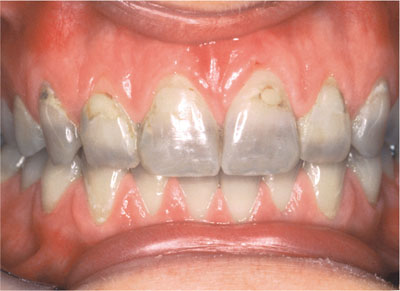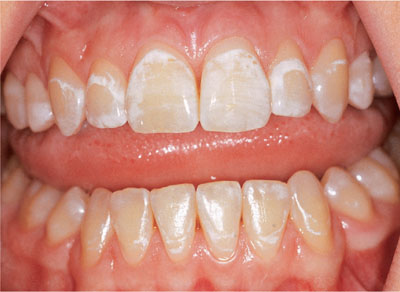Chapter 7
Frequently Asked Questions
Aim
This chapter asks and answers the most frequently asked questions.
Outcome
Practitioners will be able to answer the most common queries that patients have about bleaching.
What Causes Tooth Discolouration?
Tooth discolouration is caused by external (extrinsic) or internal (intrinsic) colourants or a combination of both (see Tables 7-1 and 7-2 and Figs 7-1 to 7-10).
| Colour | Cause |
| Brown or black | Tea/coffee/iron |
| Yellow or brown | Poor oral hygiene/tea |
| Yellow/brown/black | Tobacco/marijuana |
| Green/orange/black/brown | Bacteria |
| Red/purple/brown | Red wine |
| Colour | Cause |
| Grey/brown/black | Pulp with haemorrhage |
| Yellow/grey | Pulp necrosis without haemorrhage |
| Brown/grey/black | Endodontic materials within the tooth |
| Yellow/brown | Pulpal obliteration/sclerosis |
| Brown/white lines/spots | Fluorosis (excessive fluoride swallowed during tooth development) |
| Black | Sulphur |
| Brown/grey | Minocycline taken after tooth formation (adult teeth) |
| Yellow/brown/grey/blue | Tetracycline taken during tooth development |
| Doxycycline taken after tooth formation | |
| Pink | Internal resorption |
| Grey/brown/black | Dental decay |
| Yellow/brown | Ageing |

Fig 7-1 Extrinsic discolouration.

Fig 7-2 Intrinsic discolouration.

Fig 7-3 Pulp necrosis with haemorrhage.

Fig 7-4 Following inside/outside bleaching and shortening.

Fig 7-5 Sclerosis of both upper and central incisors.

Fig 7-6 Internal and external resoption.

Fig 7-7 Cervical tetracycline discolouration.

Fig 7-8 Oxytetracycline discolouration with orthodontic bands in position.

Fig 7-9 Following bleaching and direct composite bonding. (Photograph courtesy of Richard Porter).

Fig 7-10 Enamel decalcification after orthodontic treatment.
Are There Any Other Causes of Discolouration?
There are other causes of discolouration which have more pathological origins. These are outlined in Table 7-3 (page 100) and illustrated in Figs 7-11 />
Stay updated, free dental videos. Join our Telegram channel

VIDEdental - Online dental courses


